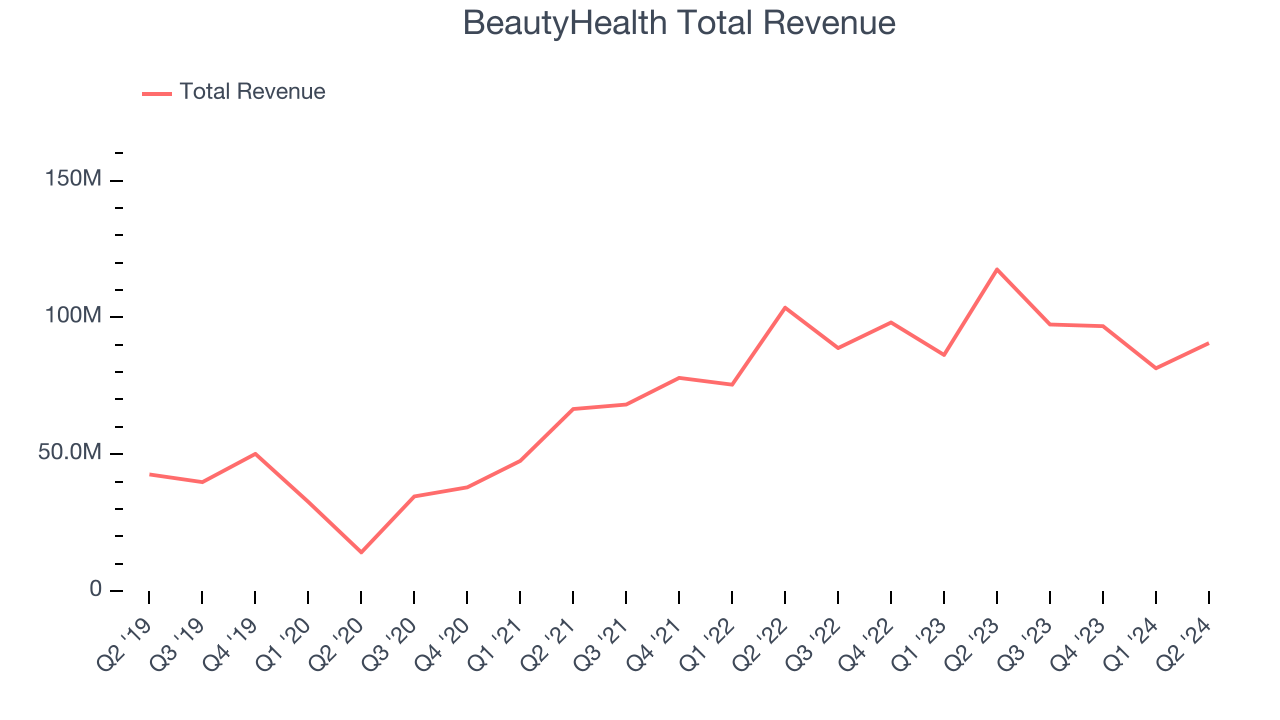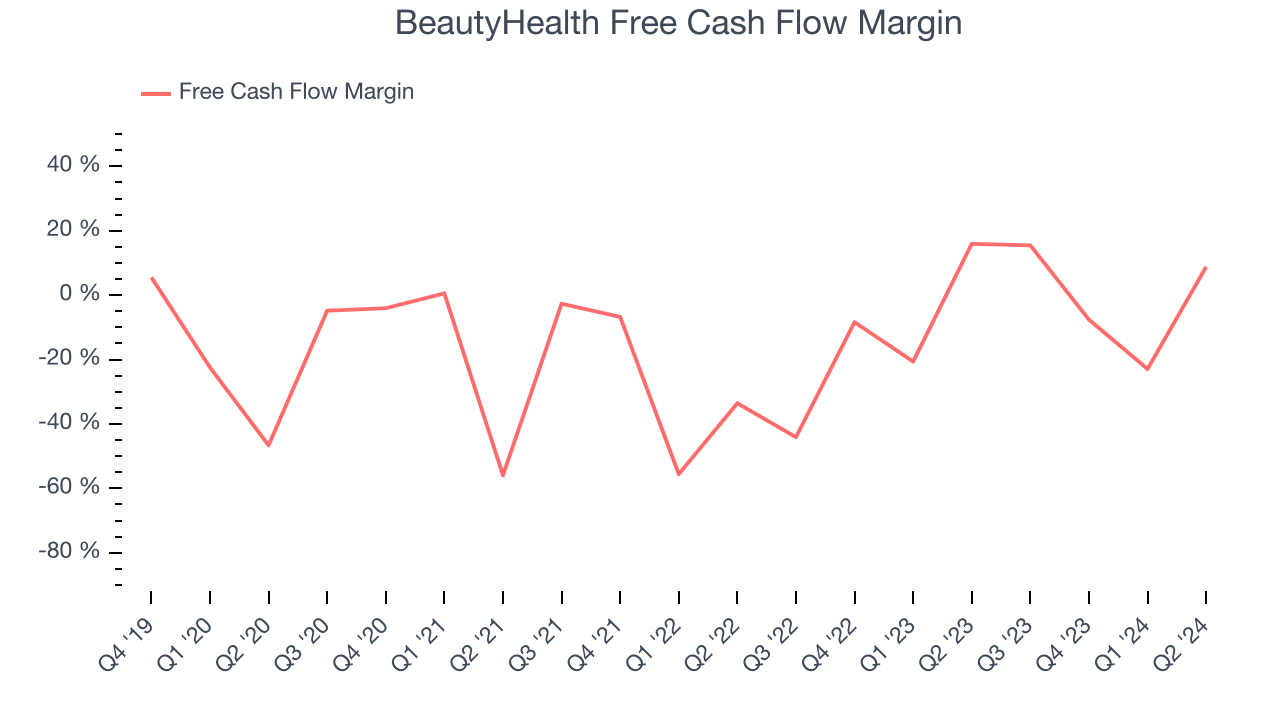Skincare company BeautyHealth (NASDAQ:SKIN) missed analysts' expectations in Q2 CY2024, with revenue down 22.9% year on year to $90.6 million. Next quarter's revenue guidance of $75 million also underwhelmed, coming in 25.3% below analysts' estimates. It made a GAAP loss of $0.10 per share, down from its profit of $0.03 per share in the same quarter last year.
Is now the time to buy BeautyHealth? Find out by accessing our full research report, it's free.
BeautyHealth (SKIN) Q2 CY2024 Highlights:
- Revenue: $90.6 million vs analyst estimates of $98.55 million (8.1% miss)
- EPS: -$0.10 vs analyst estimates of -$0.05 (-$0.05 miss)
- Revenue Guidance for Q3 CY2024 is $75 million at the midpoint, below analyst estimates of $100.4 million
- Gross Margin (GAAP): 45.1%, down from 57.8% in the same quarter last year
- EBITDA Margin: -5.7%, down from 15.1% in the same quarter last year
- Free Cash Flow of $7.96 million is up from -$18.66 million in the previous quarter
- Market Capitalization: $154.5 million
Operating in the emerging beauty health category, the appropriately named BeautyHealth (NASDAQ:SKIN) is a skincare company best known for its Hydrafacial product that cleanses and hydrates skin.
Personal Care
While personal care products products may seem more discretionary than food, consumers tend to maintain or even boost their spending on the category during tough times. This phenomenon is known as "the lipstick effect" by economists, which states that consumers still want some semblance of affordable luxuries like beauty and wellness when the economy is sputtering. Consumer tastes are constantly changing, and personal care companies are currently responding to the public’s increased desire for ethically produced goods by featuring natural ingredients in their products.
Sales Growth
BeautyHealth is a small consumer staples company, which sometimes brings disadvantages compared to larger competitors benefitting from better brand awareness and economies of scale. On the other hand, one advantage is that its growth rates can be higher because it's growing off a small base.
As you can see below, the company's annualized revenue growth rate of 25.2% over the last three years was excellent for a consumer staples business.

This quarter, BeautyHealth missed Wall Street's estimates and reported a rather uninspiring 22.9% year-on-year revenue decline, generating $90.6 million in revenue. The company is guiding for a 23% year-on-year revenue decline next quarter to $75 million, a reversal from the 9.7% year-on-year increase it recorded in the same quarter last year. Looking ahead, Wall Street expects sales to grow 13.6% over the next 12 months, an acceleration from this quarter.
When a company has more cash than it knows what to do with, buying back its own shares can make a lot of sense–as long as the price is right. Luckily, we’ve found one, a low-priced stock that is gushing free cash flow AND buying back shares. Click here to claim your Special Free Report on a fallen angel growth story that is already recovering from a setback.
Cash Is King
If you've followed StockStory for a while, you know we emphasize free cash flow. Why, you ask? We believe that in the end, cash is king, and you can't use accounting profits to pay the bills.
While BeautyHealth posted positive free cash flow this quarter, the broader story hasn't been so clean. BeautyHealth's demanding reinvestments have drained its resources over the last two years. Its free cash flow margin was among the worst in the consumer staples sector, averaging negative 6.5%.
Taking a step back, an encouraging sign is that BeautyHealth's margin expanded by 11.1 percentage points during that time. Despite its improvement and recent free cash flow generation, we'd like to see more quarters of positive cash flow before recommending the stock.

BeautyHealth's free cash flow clocked in at $7.96 million in Q2, equivalent to a 8.8% margin. The company's cash profitability regressed as it was 7.2 percentage points lower than in the same quarter last year, but it's still above its two-year average. We wouldn't read too much into this quarter's decline because investment needs can be seasonal, causing short-term swings. Long-term trends carry greater meaning.
Key Takeaways from BeautyHealth's Q2 Results
We struggled to find many strong positives in these results. Its full-year revenue guidance missed analysts' expectations and its revenue guidance for next quarter missed Wall Street's estimates. Overall, this was a mediocre quarter for BeautyHealth. The stock traded down 22.5% to $1 immediately following the results.
BeautyHealth may have had a tough quarter, but does that actually create an opportunity to invest right now? When making that decision, it's important to consider its valuation, business qualities, as well as what has happened in the latest quarter. We cover that in our actionable full research report which you can read here, it's free.
